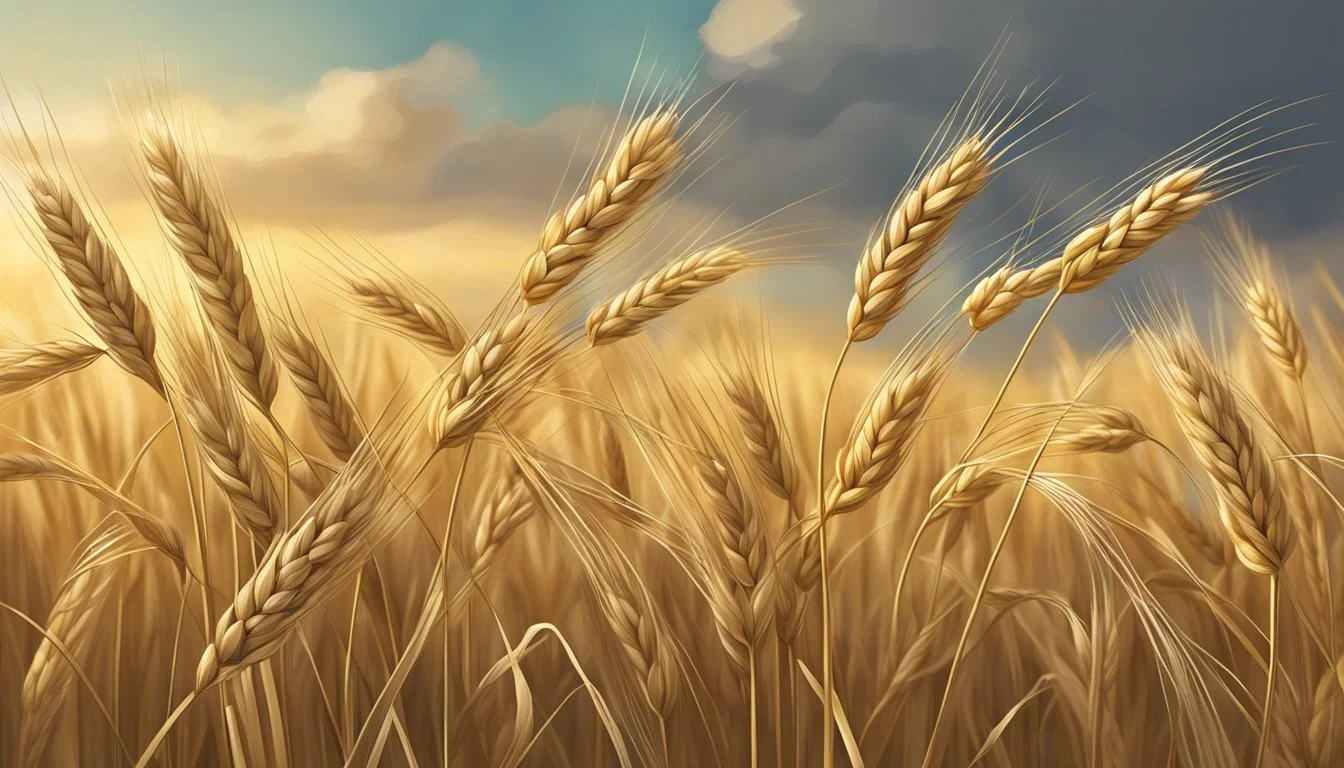How Long Does Einkorn Wheat Last?
Shelf Life and Storage Tips
Einkorn wheat, one of the earliest domesticated forms of wheat, is renowned for its longevity both as a cultivated crop and when stored properly. This ancient grain has made a comeback due to its nutritional benefits and simplicity of organic farming methods. Unlike modern wheat varieties, einkorn's genetic structure is less complex, which may contribute to its ability to be stored for extended periods without significant degradation in quality.
When it comes to storage, einkorn wheat, like other grains, has a shelf life that varies depending on a variety of factors, including the form in which it is stored – whether as whole grain, flour, or other processed forms. Under optimal conditions, whole einkorn wheat berries can last significantly longer than milled einkorn flour due to the protective outer layer of the grain which shields the inner seed from oxidation and spoilage.
The shelf life of einkorn is also influenced by the environment it is stored in. Cool, dry, dark, and airtight conditions tend to preserve the grain's quality for the longest time. This longevity ensures that those who stock einkorn wheat in their pantries can enjoy its unique taste and healthful properties over time, making it a reliable staple in many households.
Einkorn Wheat Overview
Einkorn wheat, a true ancient grain, holds significant nutritional value and has a rich story, despite its complexity in cultivation and usage when compared to modern wheat varieties.
History and Origin
Einkorn (Triticum monococcum) is one of the earliest domesticated forms of wheat, hailing from the Neolithic Revolution and originally grown in the Fertile Crescent. This grain is part of the farro family, which includes emmer and spelt, and is considered an ancestor to more recent forms like Triticum aestivum. Archaeological findings suggest that einkorn was one of the first cereals to be cultivated by humans.
Nutritional Profile
Rich in protein, fiber, and a variety of minerals such as phosphorus and potassium, einkorn wheat offers significant nutritional benefits with a lower fat content. It's also packed with essential vitamins, enhancing its profile as a healthful choice among ancient grains.
Einkorn Versus Modern Wheat
Comparatively, einkorn wheat has a more favorable composition for those with gluten sensitivities, due to its simpler gluten structure, though it is not gluten-free. It is less altered than modern Triticum species and is considered more nutritionally robust than the widely used all-purpose flour from modern wheat.
Einkorn in Cuisine
In culinary practices, einkorn flour is utilized in diverse forms, ranging from breads, pancakes, and pasta to muffins, pastries, and even banana bread. Due to its sticky nature, einkorn can be challenging in recipes, often requiring modified techniques for optimal results.
Einkorn Varieties
Notable einkorn varieties include the commercial brands like Jovial Foods, which offers white einkorn flour among other products. These varieties have become available in select markets, making einkorn an accessible ingredient for experimenting with ancient grain recipes.
Storage and Shelf Life
Einkorn wheat, an ancient grain, has excellent storage potential and, when properly stored, can provide a stable food source.
Storing Einkorn Wheat
To effectively store einkorn wheat berries for long term use, it is recommended to use 5-gallon food-grade buckets. These should be kept in a pantry or a similarly cool, dry place. The intact husk of the wheat berry naturally protects the bran and germ, making it less prone to oxidation than flour. When considering storage solutions, one must ensure the environment is free from moisture and large temperature swings, as these factors can degrade the quality of the grain.
For those preferring to have einkorn flour readily available, milling at home is a convenient option. Home milling with electric countertop mills allows for fresh flour, which should then be used within a short period to ensure maximum nutrient retention and flavor. Flour, being more exposed than whole berries, should be kept in an airtight container and can be refrigerated to extend its freshness.
Shelf Life Factors
The shelf life of einkorn wheat berries is influenced by several factors:
Temperature: Cooler temperatures are preferable, extending shelf life.
Moisture: The absence of moisture is crucial as it prevents mold and spoilage.
Oxygen: Reduced oxygen exposure limits oxidation.
Einkorn flour has a shorter shelf life than whole einkorn wheat berries due to the exposed bran and germ once milled. If stored properly, unmilled einkorn berries can last for years, while einkorn flour is best used more rapidly to maintain its nutritional profile. Good storage practices for long-term preservation can result in a shelf life of up to 20 years for the whole berries, keeping them fresh and viable as a food source.
Einkorn Wheat Applications
The versatility of einkorn wheat extends to various culinary uses, from traditional bread baking to modern adaptations in pastries and pasta. Its unique characteristics demand specific techniques and consideration in cooking and milling processes.
Cooking and Baking with Einkorn
Einkorn wheat enjoys popularity among those who appreciate its nutritional benefits and ancient grain status. It excels in a myriad of recipes where wheat is typically used. However, chefs and bakers must take into account that einkorn possesses a stickier gluten structure than other flours, which can affect the texture of the end product.
Bread: Bakers often seek out einkorn for artisanal bread due to its richer flavor. Yet, they may adjust the hydration levels in their recipes because einkorn absorbs less water than modern wheat flours.
Pasta and pancakes: Its slight nutty taste brings a distinct dimension to pasta dishes and breakfast favorites like pancakes, imparting a depth of flavor not commonly found in dishes made with all-purpose flour.
Pastries and muffins: Einkorn can be incorporated in pastries and muffins, leading to delicate, flavorful baked goods that may differ slightly in texture compared to those made with all-purpose flour.
Einkorn Wheat as Flour
Einkorn wheat stands out for its singular properties when milled into flour. Not only is the grain typically less expensive in its whole form, but it also retains nutrients better than pre-milled flour.
Milling: Home milling with devices such as the Mockmill allows consumers to grind einkorn berries into fresh flour, maintaining nutritional integrity and avoiding oxidation that occurs in pre-milled flours.
Flour Use: Freshly milled einkorn flour is prized for its application in baking everything from banana bread to pastries. Nutrient-dense and flavorful, it provides an alternative to all-purpose flour, particularly for those with wheat sensitivities.
Agricultural Aspects
Einkorn wheat, an early domesticated form of wheat, presents unique agricultural aspects worth noting. This section elaborates on the cultivation specifics and how einkorn's inherent traits contribute to disease resistance and sustainability.
Growing Einkorn Wheat
Germination and Soil Requirements: Einkorn wheat requires soil that is not overly fertile and prefers well-drained conditions. It has moderate watering needs, ensuring adequate moisture without the risk of waterlogging. The adaptations of einkorn make it suitable for growth in a variety of climates, including those that may challenge other wheat types such as emmer and spelt.
Sunlight and Fertilization: Adequate sunlight is crucial for einkorn wheat, which thrives with full exposure. It generally needs less fertilization compared to modern wheat hybrids, aligning with its sustainable cultivation practices. Although einkorn can be grown as winter wheat, it is also successfully cultivated in other seasons depending on the regional climate.
Disease Resistance and Sustainability
Resistance to Mycotoxins and Diseases: Einkorn exhibits a good resistance to common wheat diseases and mycotoxins, which can compromise wheat quality and yield. This resistance aids farmers in managing crops with fewer chemical inputs, contributing to more sustainable agricultural practices.
Harvesting: Einkorn wheat reaches maturity within approximately 100-140 days. When harvesting, one must consider the lower yield compared to modern wheat varieties, yet its hardiness and disease resistance can offset this.
Sustainability: Einkorn cultivation supports biodiversity and can be considered environmentally friendly due to its reduced need for chemical treatments. As a crop, it stands out in its compatibility with low-input farming systems, contributing to sustainable agriculture models.
Einkorn Wheat Around the World
As one of the founder crops pivotal to the Neolithic Revolution, einkorn wheat has a storied legacy that touches diverse cultures and spans across multiple continents, from the traditional fields of the Tigris-Euphrates regions to the modern health-conscious consumers worldwide.
Einkorn in Different Cultures
Tigris-Euphrates Regions: Historically, einkorn wheat's cultivation can be traced to the Fertile Crescent's Tigris-Euphrates regions, which heralded the dawn of agriculture. It was here that einkorn secured its role as a staple, eventually morphing into varied local forms of food like bulgur.
Italy: Einkorn, known as farro piccolo in Italian, holds a cherished position within their culinary practices. Families in Italy often integrate einkorn into their meals, attributing to a farm to table ethos that reveres the wheat for its nutritive qualities.
France and Spain: Einkorn, or petit épeautre in French, and locally known varieties in Spain, are occasionally found in smaller, niche markets and health food stores, as they steadily gain recognition for their rich nutritional profile and unique flavors.
Global Einkorn Distribution
Einkorn wheat has seen a resurgence in popularity thanks to individuals like Carla Bartolucci, the founder of Jovial Foods, who has been instrumental in bringing einkorn back to the grocery store shelves and into public consciousness.
Turkey: As the probable centre of einkorn's origin, Turkey remains a key player in einkorn's cultivation today.
Morocco: The wheat variety is valued for its hardiness and has found a place in Morocco's agronomy as a suitable crop for their varying climatic conditions.
Table: Einkorn Cultivation and Availability Across Key Regions
Country Cultivation Status Common Uses Availability Turkey Actively grown Traditional foods Markets, Local Morocco Actively grown Adaptable crop Markets, Local Italy Artisanal farming Farm to table cuisine Specialty stores France Niche production Health-conscious foods Health stores Spain Limited cultivation Selected culinary uses Specialty markets United States Small-scale farming Baking, health foods Online, Jovial Foods
Thus, the journey of einkorn wheat from an ancient staple to a modern delicacy continues to evolve, being adopted by farmers and favored by gourmets world over, celebrating its rich heritage and adapting to local preferences and practices.
Einkorn Wheat for Dietary Concerns
Einkorn wheat serves as a potential alternative for those with gluten sensitivities, offering a different nutritional profile than modern wheat. It may benefit those seeking a grain that is easier to digest without compromising nutritional benefits.
Einkorn and Gluten Sensitivities
Einkorn wheat, an ancient grain, contains gluten. However, its gluten content is structurally different from that of modern wheat, which may be easier on the digestive system for some individuals. Those with gluten sensitivity may find einkorn a more tolerable option, although it is not safe for individuals with celiac disease due to its gluten presence. Consuming einkorn can provide a variety of nutrients while possibly reducing the discomfort sometimes experienced with other wheat products.
Nutrient Benefit Protein Supports tissue repair and growth Fiber Aids in digestion and promotes fullness
Einkorn as an Alternative Grain
Einkorn wheat offers several nutritional benefits as an alternative grain. With higher levels of protein and fiber as compared to modern wheat, einkorn can be an excellent addition to a balanced diet. Its wheat berries, the whole grain form of einkorn, are rich in essential nutrients and can be incorporated into various meals. As an ancient grain that has remained largely unchanged over millennia, einkorn retains a robust nutritional profile that is sometimes lost in the breeding process of contemporary wheat varieties.








